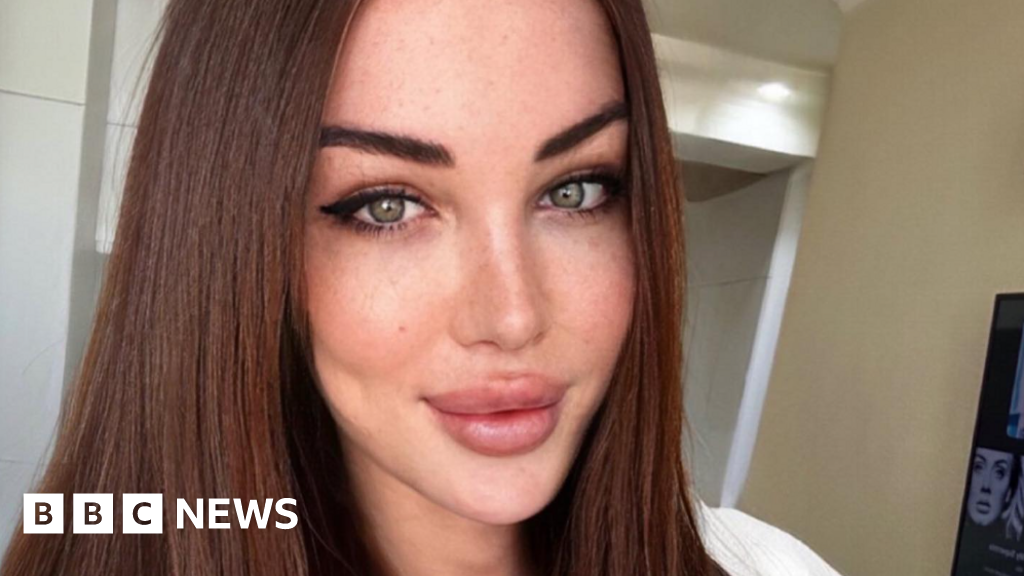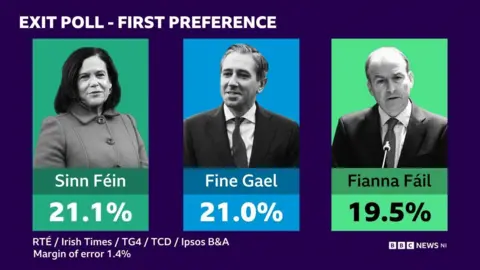 BBC
BBCAn exit poll in the Republic of Ireland suggests that Sinn Féin has 21.1% of first preference votes with Fine Gael having 21%, making the result of the general election too close to call.
The poll indicates Fianna Fáil has 19.5% of first preference votes.
It also suggests that 20% of the second preference votes goes to Fianna Fáil and Fine Gael, with Sinn Féin at 17%.
The results were published at 22:00 local time and was carried out by Ipsos B&A for RTÉ, The Irish Times, TG4 and Trinity College Dublin. It has a margin of error of 1.4%.
In the 2020 Irish general election, Sinn Féin secured 24.53% first preference votes, while Fianna Fáil obtained 22.18% and Fine Gael got 20.86%.
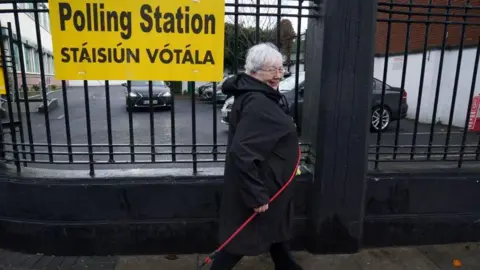 PA Media
PA MediaFriday’s poll indicates Green Party first preference support stands at 4%; Labour at 5%; the Social Democrats at 5.8%; People Before Profit-Solidarity at 3.1% and Independents at 12.7%, Independent Ireland 2.2% with others on 1.9%.
The poll is based on 5,018 completed interviews that were carried out immediately after people voted at polling stations in 43 constituencies across the Republic of Ireland.
There was a gender divide when it comes to first preference votes, the poll has suggested.
Figures show 22% of Sinn Féin voters were male, while 20% were female.
The share of male Fine Gael voters in the poll was 20%, while 22% of voters were female.
Fianna Fáil had 19% of male votes, while 20% were female.
In terms of transfers, 39% of Fianna Fáil’s second preferences went to a second party candidate, whereas 30% went to a Fine Gael candidate. About 5% of transfers went to Sinn Féin.
The poll also found that about 37% of Fine Gael transfers went to a second candidate, with 32% going to a Fianna Fáil candidate.
‘Could be a challenge’
Analysis by BBC News NI’s political editor, Enda McClafferty
Exit polls are far from an exact science, but they are a good indicator of where the votes go.
In 2020, it correctly predicted a close battle between Fine Gael, Fianna Fáil and Sinn Féin and in the end, only three seats separated the parties
If the exit poll is right this time, then Sinn Féin will be pleased with its performance.
Coming in slightly ahead of Fine Gael, but short of the almost 25% Sinn Féin secured in 2020.
The party limped into the election campaign of the back of a series of damaging controversies and poor European and local council elections in June when it secured just 12% of the vote.
Over the three-week campaign, it managed to recover the lost ground with the promise of bringing change.
But delivering on that pledge could be a challenge if the exit poll is right.
It suggests Fine Gael on 21% and Fianna Fáil on 19.5% could return to the government benches, with the help of two smaller parties and some independents.
While Sinn Féin’s path to power is more challenging as it had hoped to lead a coalition of left-leaning parties, it may struggle to get the numbers with the performance of those smaller parties.
But the true picture will only become clear when all results are in.
Counting to commence
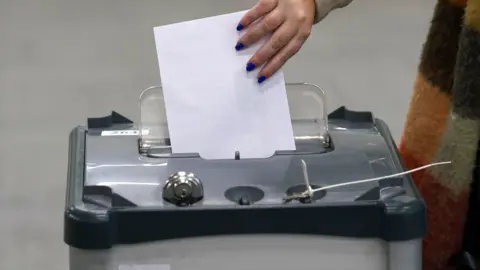 PA Media
PA MediaThe results from this poll set the scene for the official counting of votes which starts at 09:00 local time on Saturday and is expected to continue across the weekend.
It is possible that some of the 43 constituencies may not have a final result until the beginning of next week.
Successful candidates are known as Teachtaí Dála (TDs) and there are 174 seats to fill, but the Ceann Comhairle (speaker) is returned automatically.
More than 680 candidates competed for the remain 173 seats.
The number of seats required for an overall majority is 88 but no single party is fielding enough candidates to win a majority on its own.
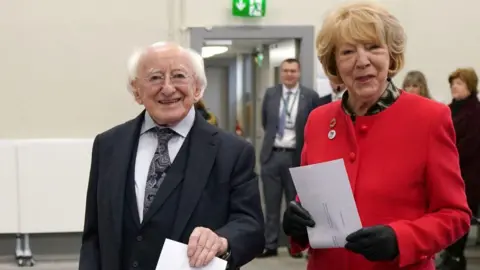 PA
PALeaders go to the polls
Earlier, Taoiseach (Irish prime minister) and Fine Gael leader Simon Harris was the first major party leader to vote.
Harris and his family travelled to Delgany National School in County Wicklow shortly after polls opened at 07:00 local time.
Micheál Martin, the tánaiste (Irish deputy prime minister) and leader of Fianna Fáil, voted with his family at St Anthony’s Boys National School in Ballinlough, County Cork.
Sinn Féin leader Mary Lou McDonald voted at Deaf Village Ireland on the Navan Road in Dublin.
Things looked a little different for Holly Cairns, leader of the Social Democrats, who gave birth on polling day.
Allow Instagram content?
Officials went the extra mile for island inhabitants on polling day.
Presiding Officer Caroline Sharkey and Garda Ronan Steede set sail to Gola Island, off the County Donegal coast on the west of Ireland, where 31 registered voters were able to submit their ballots in the living room of one of the islanders.





